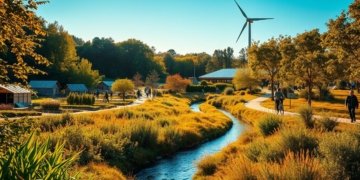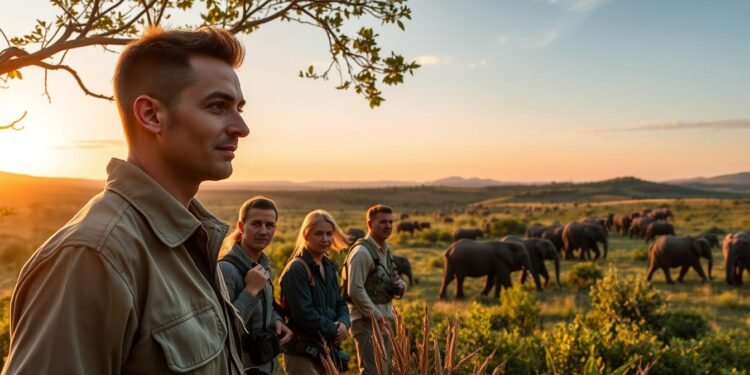Over 60 years ago, a global movement began to protect our planet’s most vulnerable species and ecosystems. The World Wildlife Fund (WWF), founded in 1961, has since become a leading conservation organization dedicated to preserving nature and its incredible diversity.
With a mission to build a future where humans live in harmony with nature, WWF has tackled critical issues like habitat destruction, climate change, and the illegal wildlife trade. Its efforts have benefited iconic species such as elephants, tigers, and rhinos, ensuring their survival for generations to come.
Operating in over 100 countries, WWF’s work has restored critical habitats, protected endangered species, and mobilized global action. Through initiatives like Earth Hour and the New Deal for Nature and People, the organization continues to inspire individuals and governments to take meaningful steps toward a sustainable future.
Key Takeaways
- WWF was founded in 1961 and is a global leader in conservation efforts.
- The organization focuses on protecting endangered species and restoring habitats.
- WWF operates in over 100 countries, addressing critical environmental issues.
- Initiatives like Earth Hour encourage global participation in sustainability.
- WWF’s mission is to create a future where humans and nature thrive together.
About the World Wildlife Fund
The story of WWF began with a shared vision to protect Earth’s natural treasures. In 1961, a group of passionate individuals, including Sir Julian Huxley and Sir Peter Scott, united to address the growing threats to our planet’s ecosystems. Their efforts led to the creation of a conservation organization that would become a global leader in preserving nature and its incredible diversity.
One of the defining moments in WWF’s history was the Morges Manifesto. This document emphasized the urgent need for funding and action to protect endangered species and habitats. Sir Peter Scott, a key figure in the organization, designed the iconic panda logo, symbolizing the mission to safeguard wildlife. Over the years, WWF has grown into a modern institution with a presence in over 100 countries, supported by millions of donors.
Organizational History and Legacy
WWF’s early years were marked by the efforts of influential figures like Prince Bernhard and Prince Philip. Their leadership helped shape the organization’s focus on addressing critical environmental issues. From its inception, WWF has worked tirelessly to unite conservationists and progressive thinkers, laying the foundation for its global impact.
Today, WWF continues to evolve under the guidance of leaders like Adil Najam. The organization’s legacy is built on decades of action and innovation, from protecting endangered species like elephants to addressing climate change. Its strategic initiatives and campaigns remain a driving force in global environmental policy.
Mission and Global Impact
At its core, WWF’s mission is to build a future where humans and nature thrive together. The organization’s work spans across critical areas such as habitat restoration, species protection, and sustainable resource management. Through partnerships and donation efforts, WWF has funded thousands of projects, benefiting both wildlife and communities.
WWF’s global reach and commitment to conservation have made it a trusted voice in environmental advocacy. By inspiring individuals and governments to take meaningful steps, the organization continues to drive positive change for our planet.
Global Conservation Efforts and Wildlife Protection Initiatives
Conservation has become a critical mission to safeguard biodiversity and restore natural habitats. Over the years, the organization has invested over $1 billion in more than 12,000 initiatives, addressing pressing environmental issues and protecting endangered species. These efforts have made a significant impact on ecosystems and communities worldwide.
Preserving Endangered Species
Protecting endangered species is a cornerstone of global conservation work. Through research, legal advocacy, and community-driven projects, the organization has helped species like elephants, tigers, and rhinos recover from the brink of extinction. These initiatives not only benefit wildlife but also strengthen local communities by promoting sustainable livelihoods.
One notable success is the recovery of African elephant populations in certain regions. By addressing poaching and habitat loss, targeted efforts have led to measurable improvements. Such achievements highlight the importance of integrating scientific research with on-the-ground action.
Habitat and Ecosystem Restoration
Restoring degraded habitats is essential for maintaining nature’s balance. Programs focus on reforestation, wetland rehabilitation, and marine conservation. These projects not only protect animal populations but also mitigate climate change by enhancing carbon sequestration.
Partnerships with local communities and governments play a vital role in addressing specific threats to ecosystems. For example, the Living Planet Report provides critical data to guide restoration efforts. By fostering collaboration, these initiatives ensure long-term benefits for both diversity and human well-being.
Approaches to Sustainability and Environmental Action
Sustainability is at the heart of modern conservation efforts, driving innovative solutions for a healthier planet. Addressing climate change and protecting nature require a mix of research, policy, and community engagement. The organization focuses on practical strategies to reduce ecological footprints and promote renewable energy.
Climate Change and Renewable Energy Research
Climate change is one of the most pressing challenges of our time. The organization invests in renewable energy research to reduce reliance on fossil fuels. Initiatives like solar energy systems and biogas installations have transformed communities, providing clean energy and improving life quality.
Collaboration with governments and industries is essential for scaling these solutions. For example, the Sustainable Blue Economy Finance Principles guide investments toward sustainable practices. These efforts not only combat climate change but also create economic opportunities.
Innovative Conservation Strategies
Innovation is key to effective conservation. High-impact campaigns like Earth Hour engage millions worldwide, raising awareness about sustainability. Digital storytelling and social media amplify these messages, inspiring individuals to take action.
Programs like the Living European Rivers initiative restore degraded ecosystems, benefiting both animal populations and local communities. By integrating science with practical strategies, these efforts pave the way for a sustainable future.
From protecting elephant habitats to reducing human-wildlife conflict, these initiatives demonstrate the power of innovation in preserving diversity. Together, they highlight the importance of collective action in building a healthier planet.
World Wildlife Fund: Our Conservation Partnerships and Campaigns
Collaboration has always been the cornerstone of impactful conservation efforts. By uniting governments, communities, and organizations, the organization has launched campaigns that resonate globally. These initiatives not only protect wildlife but also inspire collective action for a sustainable future.
Iconic Campaigns: Earth Hour and Debt-for-Nature Swap
Earth Hour, one of the most recognized campaigns, encourages millions to switch off lights for an hour. This symbolic gesture highlights the importance of energy conservation and climate action. Since its inception, Earth Hour has grown into a global movement, engaging individuals and businesses alike.
The debt-for-nature swap is another innovative approach. By reducing national debt in exchange for conservation commitments, this initiative has preserved critical habitats. Countries like Costa Rica and the Philippines have benefited, showcasing the way financial tools can support environmental goals.
Collaboration with Governments and Communities
Partnerships with governments and local communities are vital for success. For example, in Africa, collaborative efforts have reduced poaching and protected elephant populations. These alliances ensure that conservation strategies are both effective and sustainable.
Grassroots involvement is equally important. By empowering local persons, the organization fosters a sense of ownership and responsibility. This approach not only safeguards animal habitats but also improves the quality of life for communities.
Through these multifaceted efforts, the organization continues to drive meaningful change. By uniting diverse stakeholders, it ensures a brighter future for both nature and humanity.
User-Centric Digital Innovation in Conservation Storytelling
Digital innovation is reshaping the way conservation stories are shared globally. For the organization, the challenge was clear: content sprawl across separate desktop and mobile sites hindered effective communication. This fragmentation made it difficult to deliver cohesive and engaging narratives about conservation efforts.
Transitioning to a Unified Digital Experience
To address this, a custom-built Rails CMS was developed. This solution unified the digital experience, streamlining storytelling across platforms. The new system ensured consistency in messaging, making it easier for users to access information about nature and conservation initiatives.
In-depth testing and site analytics drove the redesign. By focusing on user behavior, the organization created a platform that was both intuitive and visually engaging. This approach not only improved usability but also enhanced the overall user experience.
Enhanced Engagement Through Custom CMS Solutions
The results were remarkable. Visit duration increased by 49%, and revenue per visit rose by 22%. These improvements highlight the impact of a user-centric design. Easy photo management and responsive design played a key role in delivering visually compelling stories.
This digital transformation supports the broader mission of the organization. By making information accessible and innovative, it inspires individuals to take action for the planet. Unified digital solutions also foster community engagement, creating a stronger connection between people and nature.
Through these efforts, the organization continues to lead the way in using technology to protect life on Earth. Digital innovation is not just a tool—it’s a bridge to a sustainable future.
Conclusion
For decades, a dedicated movement has worked tirelessly to safeguard our planet’s ecosystems and species. The organization has achieved remarkable progress in protecting endangered animals, restoring habitats, and engaging communities worldwide. Its unified mission and innovative digital strategies have advanced environmental action in meaningful ways.
Through collaborative partnerships, the organization has made strides in addressing critical issues like habitat loss and climate change. Cutting-edge storytelling has amplified its message, inspiring millions to take part in conservation efforts. These initiatives not only protect nature but also improve the quality of life for future generations.
Join the movement to create a sustainable future. Learn more about how you can support these vital efforts and make a difference for our planet.
FAQ
What is the mission of the World Wildlife Fund?
The mission is to conserve nature and reduce the most pressing threats to the diversity of life on Earth. This includes protecting endangered species, restoring habitats, and addressing climate change.
How does the World Wildlife Fund protect endangered species?
The organization focuses on preserving habitats, combating poaching, and supporting breeding programs to ensure the survival of species like elephants, tigers, and rhinos.
What are some key initiatives to combat climate change?
Efforts include promoting renewable energy, reducing carbon footprints, and advocating for policies that support sustainable practices to mitigate environmental impacts.
How does the World Wildlife Fund collaborate with governments?
The organization partners with governments to implement conservation policies, secure funding for environmental projects, and engage local communities in protecting natural resources.
What is the Earth Hour campaign?
Earth Hour is a global movement encouraging individuals and businesses to turn off non-essential lights for one hour to raise awareness about climate change and energy conservation.
How does the World Wildlife Fund restore ecosystems?
Restoration efforts include reforestation, wetland rehabilitation, and sustainable land management practices to revive damaged ecosystems and support biodiversity.
What role does technology play in conservation efforts?
The organization uses digital tools like custom CMS solutions and data analytics to enhance storytelling, engage supporters, and monitor conservation progress effectively.
How can individuals contribute to the World Wildlife Fund’s mission?
People can donate, participate in campaigns, adopt sustainable practices, and spread awareness about conservation issues to support the organization’s work.














